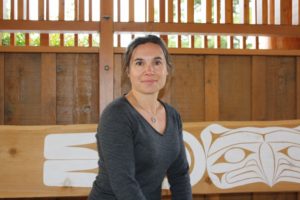The world of archeology is changing, and Camosun Anthropology instructor Nicole Kilburn and the Archaeology Field Assistant program she developed are at the forefront of that change. Kilburn developed the program in 2008 to fill a skills gap in the industry.
“Generally, if you are working [in the field] you have an undergrad in Anthropology that would include a field school,” says Kilburn, “but field schools until very recently have been almost 100 percent on excavation. So you have this funny gap between the types of skills that people finish their undergrad with and the types of skills they actually need to do the fieldwork. This program was designed to kind of fill that gap and teach people what they need to know to be field assistants.”

The program aims to teach the skills that students will need to work in the field by allowing them the opportunity to work on actual archeological sites; Kilburn recently offered the program remotely to students on to the Tk’emlúps reserve in Kamloops. The skills taught in the program include basic practical skills such as how to use a compass and how to take field notes, as well as important cultural resource management skills.
“I could create an archeology site out in the lawn out in front of the Young Building and I know my students would do a good job,” says Kilburn. “They would go out and they would dutifully map the site and take their field notes, but when we partner with Indigenous communities, it’s modelling Indigenous archeology so [it incorporates] the importance of following protocols and working with the elders and knowledge keepers.”
Kilburn says that students end up working really hard and are very concerned about being accurate and doing things right because it’s a real-life scenario and they see how it’s going to benefit that community. Kilburn says that this incorporation of Indigenous knowledge has not always been a part of archeology.
“I’ve learned a lot from my Indigenous community involvement, but I’ve had to re-examine some of the things that I learned from the old school of archeologists,” says Kilburn. “This idea that I went through my undergrad living in Coast Salish territory, talking about Coast Salish history, seeing Coast Salish archeology sites, and I did not meet a single Coast Salish person… I think about that now and that’s just not right, so I don’t want any of my students to be able to say that. I’m going to make sure that I make those opportunities to hear firsthand from knowledge keepers and to share that voice.”
Kilburn believes that BC is “leading the pack” in terms of change in archeology and says that some of the difference in what BC is doing comes from a shift in the ways in which historical sites are conceptualized.
“When Indigenous people look at those bones, they don’t see scientific potential, they don’t see data potential, they see their ancestors,” says Kilburn. “So how am I supposed to look at that? Increasingly, I look at it as their ancestors.”
These changes in the field have not come without their own set of struggles, however.
“It can be challenging, too,” says Kilburn. “There’s a lot of learning still to be done and a lot of that relationship building takes a lot of time, building trust, and [overcoming] the legacy of bad anthropology, of people who arrived with a sense of entitlement and stole ancestral remains and removed artefacts and didn’t do it in a way that was respectful. My education continues, and there have been really positive developments.”
